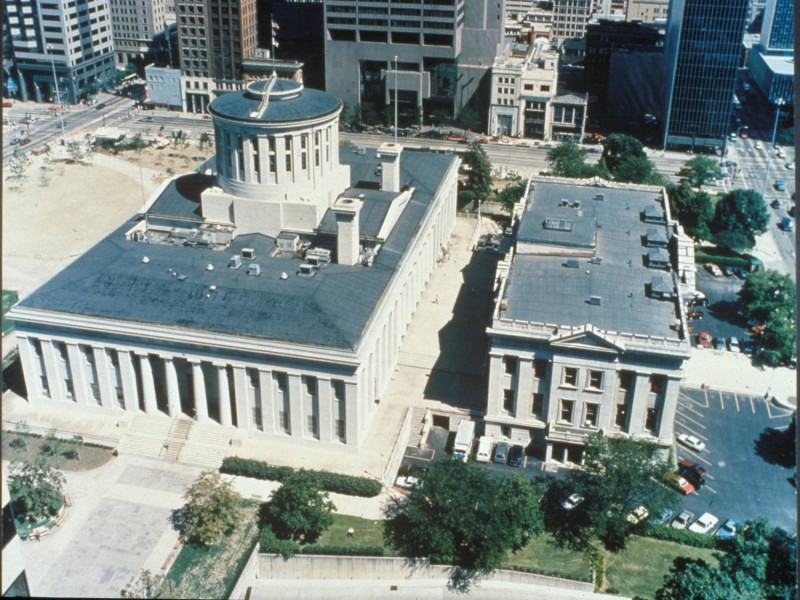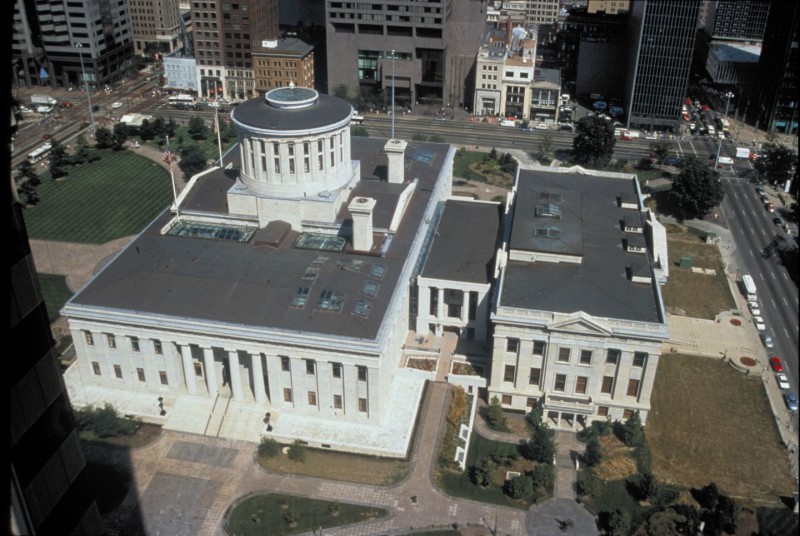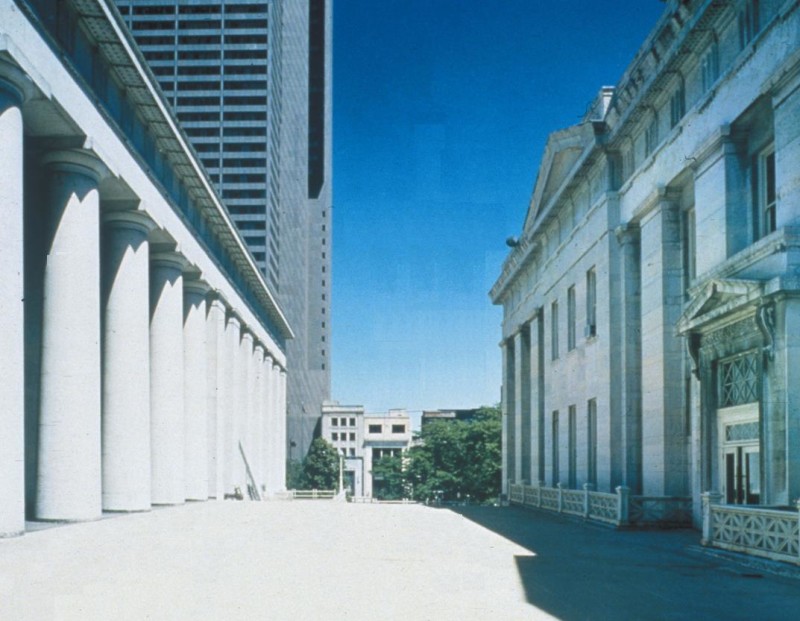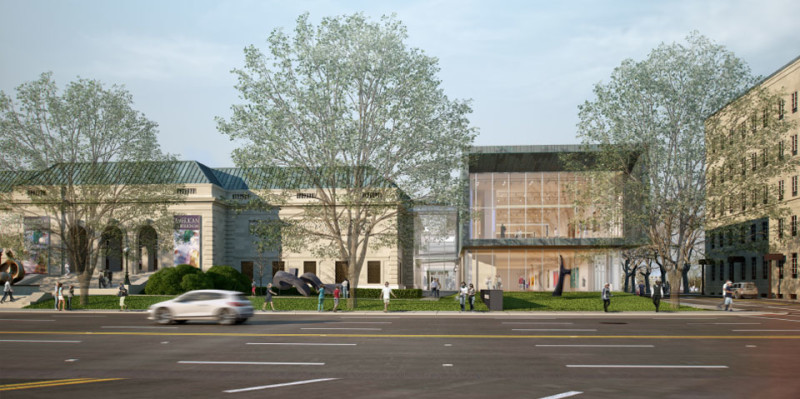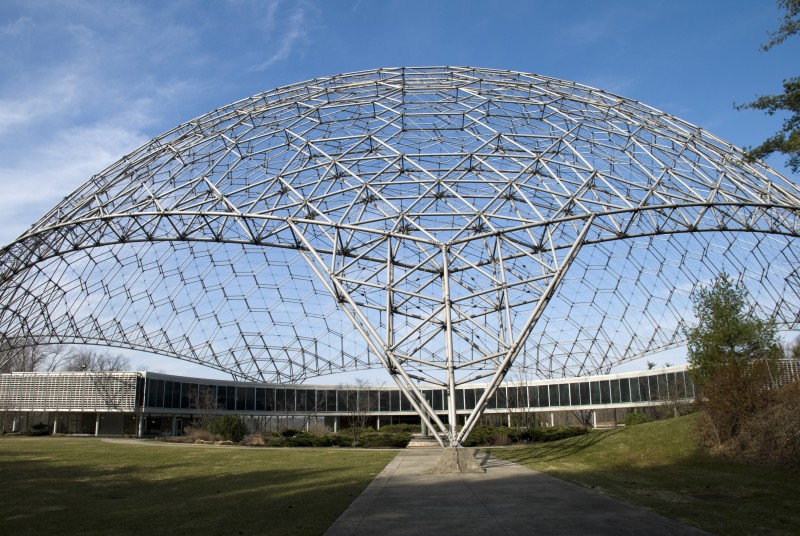Sensitive Additions To Historic Buildings: A Primer
By: Kalpa Baghasingh
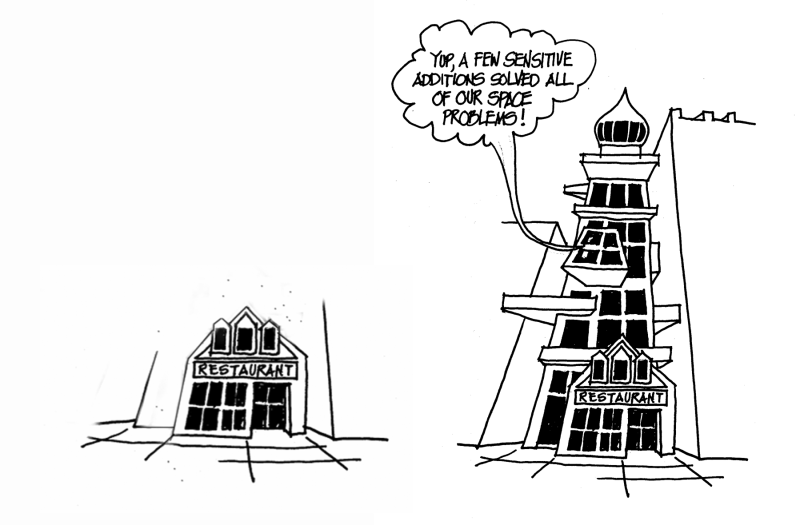
Sketch by: Jeff Gordon, AIA, Former Director of Design at Schooley Caldwell Associates, drawn for Sympathetic Additions to Historic Buildings, 2012 AIA lecture, by Robert Loversidge, FAIA, President and CEO, Schooley Caldwell Associates
Additions are one of the trickiest aspects of working with a historic building. Additions are often required for programmatic reasons. The National Park Service (the agency that develops historic preservation policy and guidance on preserving and rehabilitating historic buildings) advises that “an exterior addition should be considered once it has been determined that the new program requirements cannot be met within the existing building envelope.” Sometimes the available square footage and configuration of spaces do not meet the needs of a proposed use, and sometimes an addition is warranted to account for expansion of the current use. Many times, an addition helps in extending the life of a historic building, which would otherwise have been in danger of being abandoned or demolished for being infeasible of supporting modern uses.
Additions can be as small as an entry vestibule, or as large as entire buildings. In any case, designing an addition is a delicate balancing act–the addition should be compatible with the historic building, but should also be distinguished enough so as not to offer a false impression of being historic. In a nutshell, respect the historic building, but don’t try to pass off an addition as old. It’s no wonder then that an addition often invites opposing design philosophies and controversy.
So, what is a “sensitive” addition? The National Park Service (NPS) has published guidelines, which strives to answer this very question, and provides a sort of checklist to help achieve it:
- A new addition should be simple and unobtrusive in design, and should be distinguished from the historic building in a manner that makes clear what is historic and what is new.
- A new addition should be constructed in a way that there is the least possible loss of historic materials and so that character-defining features are not obscured, damaged, or destroyed.
- A new addition should not be highly visible from the public right of way; a rear or other secondary elevation is usually the best location for a new addition.
- The construction materials and the color of the new addition should be harmonious with the historic building materials.
- The new addition should be smaller than the historic building—it should be subordinate in both size and design to the historic building.
You can read the entire Preservation Brief #14 here.
Let’s look at a couple local examples now. The first example is a classical addition at the Ohio Statehouse, and the second one is a more modern addition at the Columbus Museum of Art.
Ohio Capitol Atrium Connector
Architect: Schooley Caldwell Associates
The Ohio Capitol Atrium was added as a connector between the Ohio Statehouse (1838-1861) and the Senate building (1899-1901) in 1993. The space was a walkway between the two buildings, and is now used as a space for conferences and special events. The addition is compatible with the neoclassical style of architecture of the Statehouse. The façade is set back from the front, and the scale is subordinate to the parent buildings. The addition looks different enough to not be confused with the historic buildings
You can read a brief history of the Connector here
Columbus Museum of Art Expansion
Architect: Design Group
This ongoing expansion project at the Columbus Museum of Art has an interesting bold design as its addition. Its minimalistic yet soaring design contrasts with the historic building, but also borrows from it. The pre-patinated copper and limestone façade has clearly been inspired by the historic building. The two-story addition is tied to the historic 1931 museum building by a recessed glass connector, which protects the integrity of the original building. This definitely pushes the boundaries of conventional “rules” regarding sensitive additions, but also emphasizes the fact that there is no one right answer when it comes to sensitive additions.
You can read more about the expansion project here:
In summary, a sensitive addition should strive to:
- Preserve the historic character and integrity of the property.
- Preserve significant historic materials and features.
- Protect the historical significance by making a visual distinction between old and new.
- Be compatible to the historic scale, mass and form.
- Be reversible.
So, the next time you come across a historic building, try figuring out if it was added on to. Or if you are looking to construct an addition to your vintage house, consider these guidelines before moving ahead.
German Village Brick Restoration Workshop
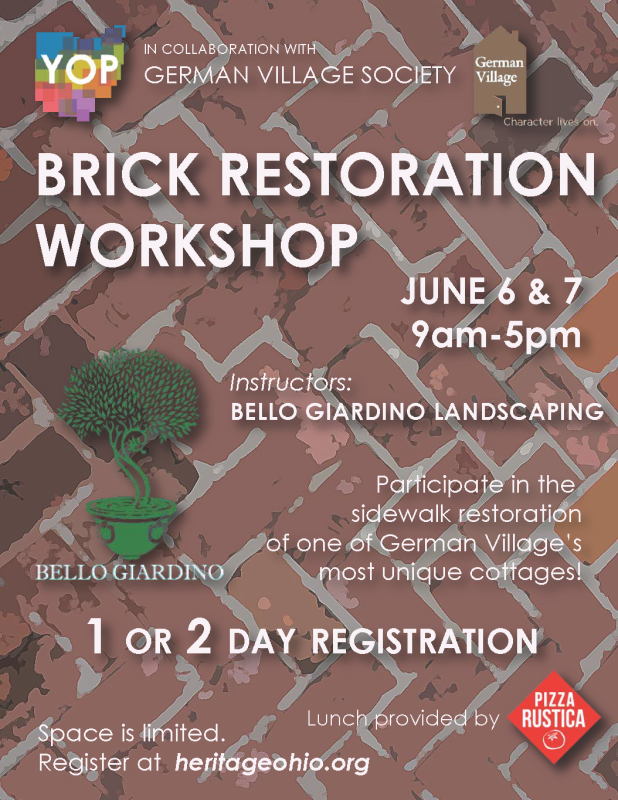
Columbus’s German Village is one of the oldest historic districts in Ohio, thanks to community members advocating for the city to include preservation as
part of urban renewal . Since the late 1950s, German Villagers have advocated for the preservation of the neighborhood’s parks, brick streets, and historic structures; today the neighborhood is advocating for sidewalk restoration and curb repair. To kick off the neighborhood’s campaign for sidewalk restoration and repair, the German Village Society has partnered with the Young Ohio Preservationists to relay the brick sidewalk of one of the neighborhood’s most unique cottages.
Learn from Bello Giardino landscapers the best methods to lay brick pavers to create a smooth walkway. These skills can be utilized to improve your own sidewalk or create a backyard patio.There will be coffee and light snacks in the morning provided by Starbucks and Pizza Rustica will be providing us with lunch.
Click Here for more information and to register for this event.
![]()
2015 Annual Awards Call for Nominations
It’s time once again to honor the people, places and projects that exemplify Heritage Ohio’s commitment to growth through preservation and revitalization. Award nominations are due by 5:00 PM, Monday June 15, 2015, for projects completed by December 31, 2014. This year, nominations will be available beginning Wednesday, May 1. We will be accepting nominations for 13 awards using the 2015 Annual Awards nomination form below.
We are continuing to encourage the submission of digital video files that tell the story of the nominee or project. Just include the video file as part of the nomination form that you submit. We look forward to seeing your nominations!
2015 Annual Awards Categories
Best Public/Private Partnership
This award is presented to an organization and/or municipality that has partnered and leveraged resources to complete a project with a positive, lasting impact in the community, with priority given to preservation-based projects. Projects completed between January 1, 2013 and December 31, 2014 are eligible. If completing a Best Public/Private Partnership, please provide these support materials:
Support Materials
- Description of the project including location and size, history, former uses, project costs, funding sources, planner, contractor/architect partnership, etc
- Explain the historical significance of the property and note if it is listed in any national, state or local register or inventory
- Make note if tax credits were used on the project
- Describe the work completed including any design assistance sources, financial incentives and project challenges
- Images/video of the project, especially highlighting before and after conditions
Best Residential Rehabilitation
This award is presented to one or more individuals, tenants or homeowners who have completed the best exterior and/or interior single or multi-family residential project based on proper preservation techniques. Projects completed between January 1, 2013 and December 31, 2014 are eligible. If completing a Best Residential Rehabilitation nomination, please provide these support materials:
Support Materials
- Describe the rehabilitation project including the location, design principles, design assistance used, costs, funding sources, financial incentives used, contractor/architect partnership, etc
- Detailed description of the work completed throughout the rehabilitation process including project challenges encountered and resolved
- Images/video of the project, especially highlighting before and after conditions
Historic Farmstead of the Year
This award is presented to the historic farmstead which best embodies the marriage of modern agricultural practices with historic buildings, or best embodies the innovative reuse of historic agricultural buildings. Nominees will be judged on the basis of maintained integrity of farm buildings/outbuildings for continued use, or the completed rehabilitation of a farmstead for either agricultural use, or for a new sympathetic use. Farmsteads listed in the National Register of Historic Places, or as a Centennial Farm through the Ohio Department of Agriculture are especially encouraged to apply. If completing a Historic Farmstead of the Year nomination, please provide these support materials:
Support Materials
- Description of current farmstead and uses, whether agricultural or non-agricultural
- Explain the historical significance of the farmstead and note if it is listed in any national, state or local register or inventory
- Describe major work completed on any buildings or outbuildings, especially as part of a large rehabilitation project
- Images/video of the farmstead, especially highlighting before and after conditions
Historic Theater of the Year
This award is presented to the historic theater, opera house, or cinema which embodies the spirit of preservation. Nominees will be judged for maintained integrity or completed restoration projects, active performance or screenings, and community engagement. If completing a Historic Theater of the Year nomination, please provide these support materials:
Support Materials
- Description of current programming and community engagement activities
- Explain the historical significance of the property and note if it is listed in any national, state or local register or inventory
- Describe the work completed on structure, either continuous maintenance or completed restoration project
- Images/video of the building, especially highlighting before and after conditions and performance
Main Street Business of the Year
This award is presented to the owner(s) and/or employee(s) of a Main Street program business with innovative strategies. If nominating a Main Street Business, please provide these support materials:
Support Materials
- Detailed description of the business’ history with the local Main Street Program, examples of its involvement at the local level and its dedication to revitalization and preservation
- Images/video of the nominee in action
Volunteer of the Year
This award is presented to an individual dedicating their time and effort toward helping their Main Street program thrive. If completing a Volunteer of the Year nomination, please provide these support materials:
Support Materials
- Detailed description of the volunteer’s actions, achievements, and involvement in the organization, and how these have benefited the community and enhanced the community’s downtown
- Images/video of the nominee in action
Spirit of Main Street
This award is presented to an individual, organization, or business dedicating their time and effort toward helping their Main Street program thrive. If completing a Spirit of Main Street nomination, please provide these support materials:
Support Materials
- Detailed description of the volunteer/staff member actions, achievements, and involvement in the organization, and how these have benefited the community and enhanced the central business district
- Images/video of the nominee in action
Best Downtown Placemaking
This award is presented to an organization and/or municipality actively engaged in efforts to enhance their downtown’s appearance with the intention of creating public spaces that promote people’s health, happiness, and well being through a program of streetscape improvements. If completing a Best Downtown Placemaking nomination, please provide these support materials:
Support Materials
- Description of the project including reasoning behind implementation, project costs, funding sources, etc
- Explain the historical significance of the property and note if it is listed in any national, state or local register or inventory
- Describe the work completed including any design assistance sources, financial incentives, project challenges, and innovative approaches to overcoming project obstacles
- Images/video of the project, especially highlighting before and after conditions
Main Street Manager of the Year
This award is presented to a Main Street Manager contributing exceptional efforts to downtown revitalization. If nominating a Manager, please provide these support materials:
Support Materials
- Detailed description of the person’s tenure as main street manager, his/her involvement as the Main Street Manager and his/her commitment to revitalization and preservation
- Images/video of the nominee in action
Best Main Street Committee Project or Event
This award is presented to the Main Street program committee (Business Enhancement/Economic Restructuring, Design, Operations/Organization, Marketing/Promotions) displaying excellence in Main Street activities. If completing a Best Main Street Committee Project or Event nomination, please provide these support materials:
Support Materials
- Description of how the event or project fulfilled an unmet need in the community
- Describe how the event or project positively impacted the downtown/community through event activities, increased attendance, etc
- Provide information about the cost funding sources, and the implementation process
- Images/video of the project materials and project efforts in action
Preservation Hero
This award is presented to an individual, organization, or business that has shown outstanding leadership in revitalizing and preserving Ohio communities. If nominating a Preservation Hero, please provide these support materials:
Support Materials
- Detailed description of the person’s or organization’s involvement in the historic preservation field, the activities undertaken, and how their actions made a positive preservation impact
- Images/video of the nominee(s) in action
Best Commercial Rehabilitation
This award is presented to one or more individuals, tenants or building owners who have completed the best storefront, interior and/or total building improvement project based on proper preservation techniques. Projects completed between January 1, 2013 and December 31, 2014 are eligible. If completing a Best Commercial Rehabilitation nomination, please provide these support materials:
Support Materials
- Description of the rehabilitation project including building location and size, building history, former building uses, project costs, funding sources, contractor/architect partnership, etc
- Explain the historical significance of the property and note if it is listed in any national, state or local register or inventory
- Make note if tax credits were used on the project
- Describe the work completed including any design assistance sources, financial incentives and project challenges
- Images/video of the project, especially highlighting before and after conditions
Best Public Leader in Revitalization
This award is presented to an individual that has shown outstanding leadership in revitalizing and preserving Ohio communities. Candidates are likely to be elected officials (commissioners, mayors, representatives, but may also be city manager, fire chief, etc.) If nominating a Best Public Leader please provide these support materials:
Support Materials
- Detailed description of the person’s involvement in the historic preservation field, the activities undertaken, and how their actions made a positive preservation impact
- Images/video of the nominee(s) in action
Heritage Ohio Board Meeting
Columbus, Ohio
Program Funding Workshop – Cambridge
Revitalization Series Autumn Workshop
Funding Downtown Programs
Cambridge, Ohio
11/18/2105
Join us in Cambridge, Ohio on November 18th as Main Street directors and board members from around the state share their best funding strategies. Attendees will hear about major fundraising events, sustainable membership campaigns, annual benefits, merchandise sales, government contributions and various other strategies to build a local budget.
Workshop Location
Francis Family Restaurant
1038 Wheeling Avenue
Cambridge, Ohio 43725
Agenda
9:30 – Registration
10 – Training Commences
12 – Lunch
5 – Training Concludes
REGISTER HERE
Lodging Options
Quality Inn Cambridge, 1945 Southgate Pkwy, Cambridge, OH 43725 740-439-3581 I am willing to offer a special rate for your event of $79 plus tax. This will include a hot breakfast in the morning and also will include any early/Late check out fees. They may call the hotel directly to receive the discounted rate @ 740-439-3581.
Hampton Inn, 8775 Georgetown Rd, Cambridge, (740) 439-0600 $89.00 for double queens at the Hampton (regularly 130.00)
Microtel, 8779 Georgetown Rd, Cambridge, Phone:(740) 435-8080 single queen rooms and double queens for $49.00 (regularly 79.00-89.00) All of our rooms at both properties have a fridge, microwave, wired and wireless free internet throughout the hotel, flat screen HD televisions.
Comfort Inn, 2327 Southgate Parkway, Cambridge, Phone (740) 435-3200 The rates will be $89.99 + tax for the Main Street Training. We offer a hot breakfast, free wireless internet, fitness center, indoor pool.
Revitalization Training- Design, Greenville
Walkability/Bikeability
Greenville, Ohio 45331
Exploring Ohio’s Mid-Century Architecture Webinar
Join us June 3, 2015, 1 PM-2PM
 From glass-curtain wall skyscrapers to suburban ranch houses, mid-century properties reflect important architectural design and historic themes illustrating Ohio’s recent past. Join Barbara Powers from the Ohio History Connection to learn about modern architecture in Ohio. The webinar will focus on ten significant buildings and places illustrating the broad social, political, and economic trends shaping land use, architectural design, and building technology from the 1940s to 1970s.
From glass-curtain wall skyscrapers to suburban ranch houses, mid-century properties reflect important architectural design and historic themes illustrating Ohio’s recent past. Join Barbara Powers from the Ohio History Connection to learn about modern architecture in Ohio. The webinar will focus on ten significant buildings and places illustrating the broad social, political, and economic trends shaping land use, architectural design, and building technology from the 1940s to 1970s.
Register Here
Heritage Ohio Rides to Greenville
In an effort to highlight western Ohio’s great network of bike trails and in conjunction with our September 1st bikeability workshop, the staff at Heritage Ohio is making the long trek to Greenville. On August 30th we will be departing from Columbus for the first leg of our trip and plan to stay the night in Dayton. On the 31st, we will make our way from Dayton to Greenville for the following day’s workshop.
The schedule is tight and we do not much time to remain in any one community, but we would love to see you while we are in your town and hopefully get some photos of you and your community to post to our various social media channels. Our goal is to raise awareness around biking and let people across Ohio know the great bike access in your area.
HERE you will find our itinerary for the 2 day trek. We hope you will consider coming out to visit with us while we are in your town.
Please email (info@heritageohio.org) and let us know if you are available to meet for a little while on Sunday or Monday and tell us more about your town.

Who do you think will make it all the way? You can support us HERE and pledge for the rider you want to support.
Heritage Ohio Board Meeting
10 AM -2PM


